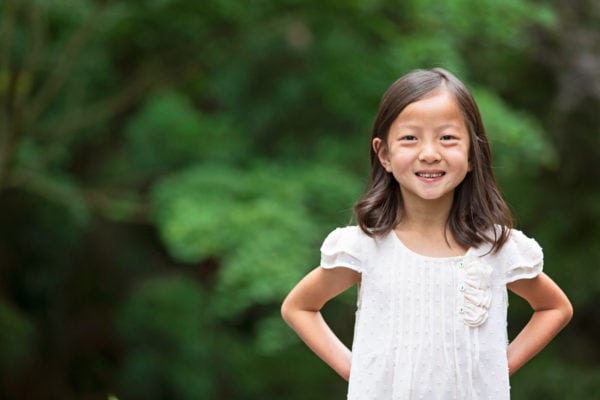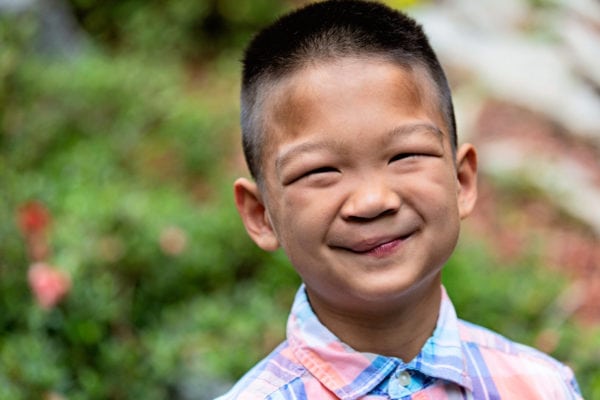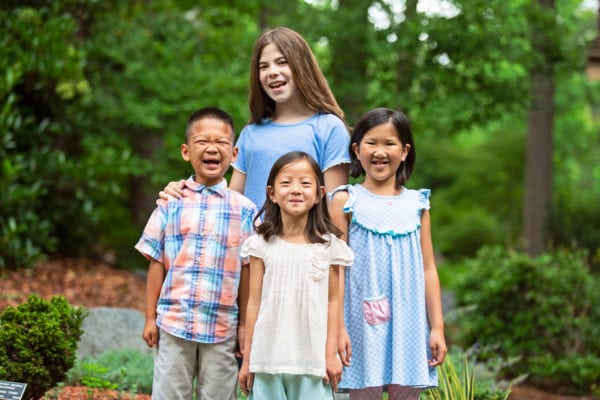Attachment. It’s a word that, at some point of the adoption journey, will bring every parent to their knees – either in frustration over all that seems to be lacking or gratitude for heart-shaped milestones reached.
This month we are focusing on attachment over the long(er) term… not weeks or months home. But years down the road. And we’ve asked our contributors to share their experience – exactly what attachment is like with their child, exactly where they are on the attachment journey.

1. Every adoptive parent starts out with certain expectations for what attachment and bonding will be like. How has your attachment looked like what you expected?
Four years ago, we welcomed a son and daughter into our family through dual adoption. Eli and Evelyn were our third and fourth children. It was our second (and third!) adoption. We had been through it, read books, been trained, and were immersed in the adoption community. We’d seen and heard variations of the adoption story. We knew to be ready for anything.
Our story is exactly what I expected. Unique and our own. We expected to have to be patient, and to have to lead our hearts, and we did. We expected it to turn our lives upside down, and it did.
2. How has your attachment looked different from what you expected?
Having expectations in adoption is messy business. They will rarely be met, as the bringing together of lives is as traumatic as it is wondrous.
Nothing could have prepared us for these two little humans, for the strangers that were handed to us as a son and daughter.
Our adoption agency had us travel first to our son, so we could have bonding time with him before shifting our attention to our daughter’s complex needs. He was quiet, but sweet, giving us a first smile on the van ride from the orphanage. He was “easy” yet would have found it an adventure to go with anyone. His attachment needs were more subtle.
Our daughter was fiercely bonded to her nanny and nurses, who flew her throughout China for surgeries and hospitalizations. She feared strangers due to medical trauma. Bonding with her was intimidating. She cried for hours, and fought for days, until her health took the strength from her fight. She was hospitalized not long after we arrived home.
Then sadly, to our surprise, all the emergency tests and procedures forged quick bonds to us as we spent weeks lying beside her in a hospital bed.
The process of attachment is both beautiful and daunting. It’s natural and hard. Forcing a bond is impossible. One can only surrender with hope to the process, and commit to prayer and working at it, bit by bit, day by day.

3. Have you ever felt like you could say, “We are attached”? If so, when?
Yes, but I couldn’t put a pin in the calendar. It emerged gradually, within our love soaked, gloriously mundane lives. It happened over breakfast and baths, playing and picture books, tuck ins and talking through tantrums.
There were turning points though. We all felt differently at the six-month mark, and then the year. Even still, for years after, I’d suddenly realize that one of the kids would hold me or look at me differently or take comfort a bit more fully.
As we came to know each other, I could look back and see how both kids’ attachment grew over time. I could better read their expressions, and see distant pain, in earlier photos.
Our closeness has waxed and waned, as in all relationships, but we are mother and children, bonded up for life.

4. What are three things you are glad you did to build attachment?
– My husband and I were mostly the main caregivers. We didn’t fully cocoon, but we were at home when possible. Between our arduous adoption process, month-long China trip and plummet into surgeries and hospital stays, we were too shell shocked and exhausted to do anything but keep life “simple”.
– We treated them like babies. Though they were 2 and 3, we cared for them as new babies in the family, with skin to skin closeness, eye to eye contact, and bottle feeding.
– Though we were intentional, we gave attachment time. We didn’t force its arrival. I’m not sure how it was both/and, but it just was. We gave each other grace, and our true feelings permission to flow.
We repeatedly tried to consider the kids’ perspective, and how we had taken them from all they knew. We didn’t expect them to love us immediately. Feelings are too wild and unruly to be forced, so we just tried to gently lead their hearts and ours. If we had treated their attachment like a project, I would have felt like a failure all the time, which would not have helped our bonding.
Note: We gave ourselves permission to break the “attachment best practices” for our sanity and the health of our family. In China, we held them in baby carriers, but also pushed them in strollers. We didn’t co-sleep, though we spent lots of time in the kids’ rooms. We were the main caregivers, but took a couple short dates to gasp for air and re-center ourselves. We trusted that every action we took wouldn’t make or break their attachment. We kept our eyes on the long view and prayed our guts out.
5. Four years out, what is something you would do differently if you were to do it all over again?
– I’d serve up even more grace. We did the best we could do at the time. It was imperfect, but it was us.
– I’d be more intentional about joy, even in the chaos.
– I’d cling harder to my husband. With the changes and medical challenges, we were in triage, and I was in “every man for himself” mode.

6. How would you encourage an adoptive parent a few years behind you regarding the attachment journey?
– Let your story be unique. There are many attachment best practices, which have helped many families, but your needs are individual.
– Talk to adoptive families, read, and fill your toolbox with practical attachment tips.
– Be intentional, but don’t overthink. Before we adopted, a mentor family asked us to thoughtfully consider not overthinking. To not create attachment issues by being so over vigilant in searching for them. Children sense a parent’s emotional temperature, which can impede feelings of safety.
– Be honest about your feelings, and then lead your heart. Adoption is a beautiful process, but also challenging. My feelings needed to be acknowledged before I could lead myself into a healthier place.
– If you are married, keep your marriage high on the triage list.
– Know in advance that you’ll make mistakes and need do-overs.
– Each parent and child will have a unique experience. My husband and I had bonding struggles at different times. Dump grace on everyone.
– Fight for joy. Shared giggles are healing and bonding.
– Remember that you need to take steps to attach and love your fragile children well, but you are not their savior. You can’t heal all the wounds. You don’t have it in you. That’s God’s job, thankfully.


























Thank you for your honest words, Rebecca. We are four months home with our son. This is the most helpful thing I’ve read on attachment since being home. Of course now I get. There is no way to experience it until you do it.
I especially liked acknowledging your feelings before healing and attachment can take place in your own heart. So key! Blessings to you.
Such good insight and advice, Rebecca! Treating them like babies, even though they were 2 and 3 resonated with me. It’s such a process and there really isn’t a finish line.